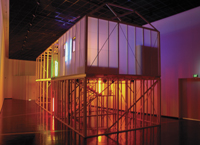Domenico de Clario
A Second Simplicity
Australian Centre for Contemporary Art
111 Sturt Street Southbank Melbourne, August 2005

Dom de Clario's walk-up apartment, shanty-built inside ACCA for the duration of the show, the rooms mimic his parent's little apartment in Trieste of the early 1950s. Very like Do-Ho Suh's recreations of his Korean family homes, similarly slightly but inintentionally creepy. Guests invited to lunch, one or two per day, homecooked by de Clario and his gentle, now elderly parents, the lunch conversation amplified out to the gallery visitors below via miked-up guests. The food was good but not too good, definitely simple. Conversation and lunch slated for one hour, which spun out to two. A little genteel, middle-class hesitancy at the start of the meal, formal introductions to de Clario's parents, whose presence throws the conversation off-course from art world gossip onto the food itself, and then onto food across the north of Italy. I'm reminded vaguely of the dinner-party conversation film genre, Bergman, French films, which neither guest wishes to puncture. I'm surprised by how little selfconsciousness is caused by sound amplification across the gallery beyond, more by the complication of the cross-generational guest mix and the charisma of de Clario's intensely intelligent, very beautiful mother (in her 70s, early 80s?), all of which leads into a focus on aging, on generational politics, on the bleakly self-censoring artworld, on the conceptual poverty of art school ecosystems. Before lunch, I guess I expected something of the ceremony of NYC-based artist Lee Mingwei's invitation-only events (to sleep with the artist, to have dinner with the artist, to accept money from the artist). I knew I didn't want to be part of a Linda Montano/Tehching Hsieh moment (tied together by a short rope for a whole year). I don't know how or if the lunches coalesced, but I suspect the result is more sociological - a portrait of the chattering class's anguish and aging - than an iconic collective image of community. If this is the case, then the work emerges quite differently to most of de Clario's recent performances and sculptures, for the sculpture/sculptor as avatar disappears.
Charles Green
Australian Centre for Contemporary Art
111 Sturt Street Southbank Melbourne, August 2005

Dom de Clario's walk-up apartment, shanty-built inside ACCA for the duration of the show, the rooms mimic his parent's little apartment in Trieste of the early 1950s. Very like Do-Ho Suh's recreations of his Korean family homes, similarly slightly but inintentionally creepy. Guests invited to lunch, one or two per day, homecooked by de Clario and his gentle, now elderly parents, the lunch conversation amplified out to the gallery visitors below via miked-up guests. The food was good but not too good, definitely simple. Conversation and lunch slated for one hour, which spun out to two. A little genteel, middle-class hesitancy at the start of the meal, formal introductions to de Clario's parents, whose presence throws the conversation off-course from art world gossip onto the food itself, and then onto food across the north of Italy. I'm reminded vaguely of the dinner-party conversation film genre, Bergman, French films, which neither guest wishes to puncture. I'm surprised by how little selfconsciousness is caused by sound amplification across the gallery beyond, more by the complication of the cross-generational guest mix and the charisma of de Clario's intensely intelligent, very beautiful mother (in her 70s, early 80s?), all of which leads into a focus on aging, on generational politics, on the bleakly self-censoring artworld, on the conceptual poverty of art school ecosystems. Before lunch, I guess I expected something of the ceremony of NYC-based artist Lee Mingwei's invitation-only events (to sleep with the artist, to have dinner with the artist, to accept money from the artist). I knew I didn't want to be part of a Linda Montano/Tehching Hsieh moment (tied together by a short rope for a whole year). I don't know how or if the lunches coalesced, but I suspect the result is more sociological - a portrait of the chattering class's anguish and aging - than an iconic collective image of community. If this is the case, then the work emerges quite differently to most of de Clario's recent performances and sculptures, for the sculpture/sculptor as avatar disappears.
Charles Green

0 Comments:
Post a Comment
Note: Only a member of this blog may post a comment.
Subscribe to Post Comments [Atom]
<< Home